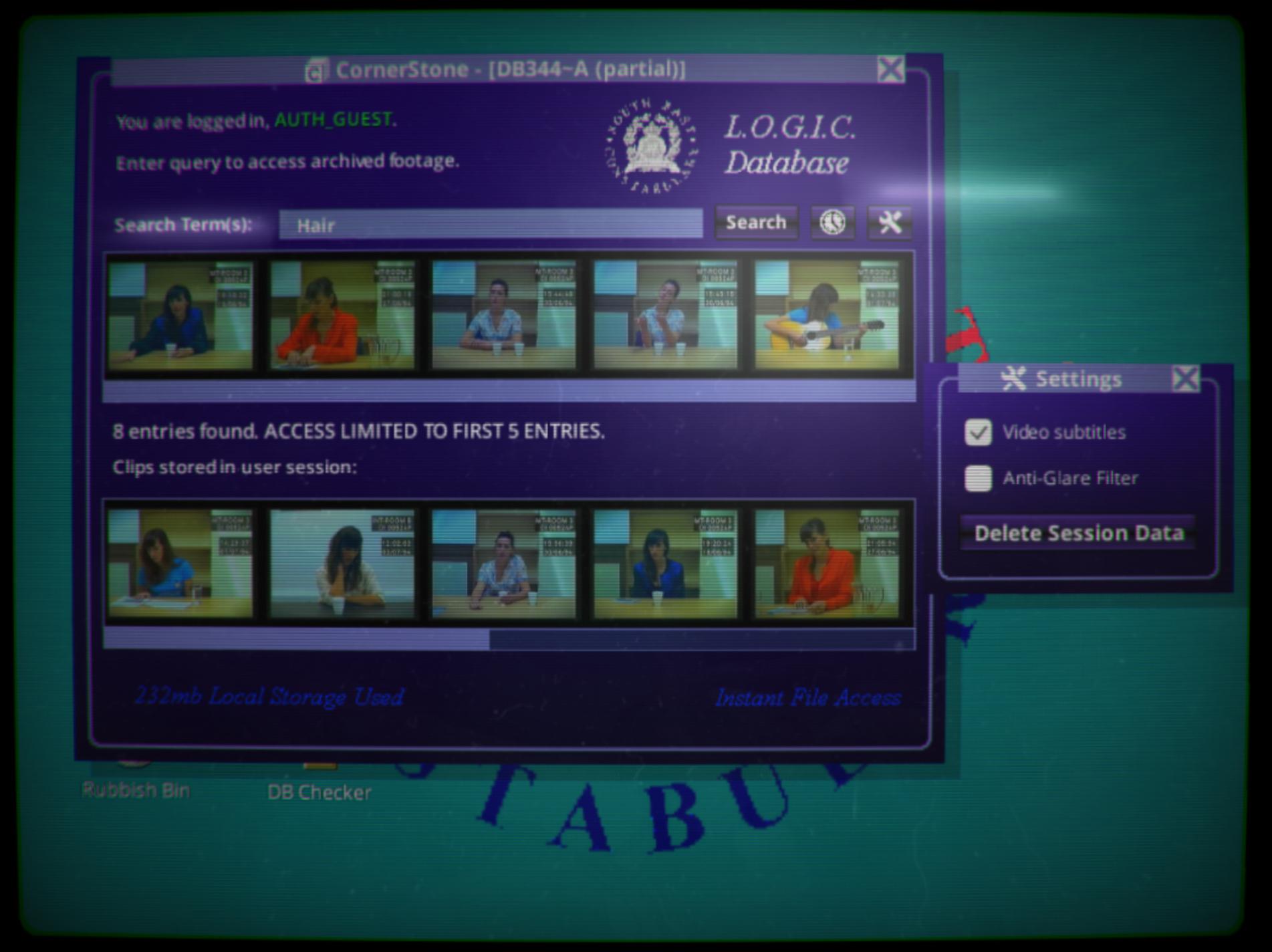Her Story is a mystery game by Sam Barlow published in 2015 for PC/iOS, and later Android—I played on iPad. Told through Interactive Film, the player explores a police archive of a woman interviewee to uncover the mystery behind the murder of her husband, Simon. While Her Story possesses excellent components (notably acting and overall narrative mystery), its simple gameplay loop and open-endedness leads to frustrating arcs which emphasize design flaws instead of player intelligence.
Despite its shortcomings, Her Story has much to enjoy. It expertly establishes verisimilitude to create a cohesive immersive boundary; the interface resembles 90s devices, and the interviews look and feel like archived recordings. The player enters without forced instructions, and must explore the narrative embedded within to find Readme.txt files which describe the game’s mechanics without breaking immersion. In this sense, the “expositional dump” of onboarding feels natural: complicated online systems would be accompanied solely by a user-guide.

The guide details the game’s short interaction loop: query the database, watch videos for information, then re-query. Barlow utilizes the retro-interface to subversively introduce challenge within the loop: the mechanic of device storage limiting queries to 5 entries creates a dynamic where the player must get creative to narrow their search. Meanwhile, the database’s “lost” recordings of interviewer prompts/questions forces the player to deduce questions solely from responses, whilst allowing the player to assume the role of investigator—contributing both to challenge and an enacting narrative structure.

With players immersed, the game Her Story can focus on the embedded narrative constructed by actress Viva Seifert’s performance, becoming an adventure to watch testimonies and reconstruct the non-chronologically presented narrative to unravel the mystery. Unfortunately, I found the player’s excessive freedom made actual exploration of the mystery among the weakest aspects of the game. The game’s simple gameplay loop leads to minimal variability; I quickly found querying repetitive, as I systematically queried words/phrases for relations. In under 20 minutes, I discovered a critical revelation by connecting seemingly innocuous but otherwise unique phrases. I eventually searched “story,” which led to a wildly specific mentioning of Rapunzel. Querying “Rapunzel” showed an unusual thumbnail of the interviewee playing the guitar. This led to her singing a song about one jealous sister drowning the other, which screamed symbolic importance. By searching “sister,” I arrived at a key component of the game’s major mystery, which granted more unique search queries to quickly gain the whole picture.

While I quickly reached this discovery, it felt less as a success of my investigational skills, and more like an oversight of player freedom while searching. Upon reaching this point, I found myself generally past the “fake story” arc the character tells early on, and onto the “real story” arc of investigating the character’s identity and involvement with Simon. This meant that many previous clips became irrelevant, barring those from the “Final” Interview tantamount to constructing the truth.
While initially excellent towards constructing player immersion, excessive freedom and lack of guidance became Her Story‘s most prominent weakness: the ability to quickly construct the secret narrative made doing so less satisfying. Moreover, despite initial joy at fulfilling the psychological need for achievement by discovering the secret, I was left wondering what to do next. Without any progress indicators while exploring, I blindly searched for more entries, unsure if I had missed an important story element. Eventually, after watching numerous clips from earlier interviews (possessing a fake story from a surpassed, now irrelevant arc), the “Chit Chat” bubble appeared, which leads to the credits without further narrative exploration. Overall, the game’s open-endedness and lack of progress indicators left me frustratedly wasting time investigating, without receiving additional narrative context.

As I ended the game, the immersive environment, overall narrative constructed, and initial discovery experience was thoroughly enjoyable, making Her Story feel excellent from a narrative perspective. However, the repetitive motions, ease of obtaining critical information, and ambiguity of player progress/stopping points, results in Her Story feeling weak from a gameplay perspective. Ultimately, I felt less like a detective making a fantastic discovery about a case, and more like a tired police officer forced to look at interview recordings until permitted to stop.



